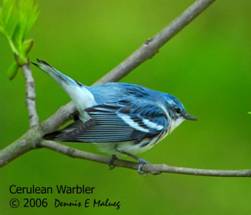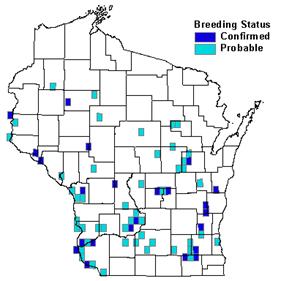Photo by Dennis Malueg


Status/Protection
- Global Rank: G5 Key to global and state ranks
- State Rank: S2S3B
- WBCI Priority: SGCN, PIF, State Threatened
Population Information
Federal BBS information can be obtained at http://www.mbr-pwrc.usgs.gov/bbs/bbs.html by clicking on Trend Estimates and selecting the species in question. All estimates are for 1966-2005.
*Note: There are important deficiencies with these data. These results may be compromised by small sample size, low relative abundance on survey route, imprecise trends, and/or missing data. Caution should be used when evaluating this trend.
- Federal Breeding Bird Survey: significant decline
- Federal Breeding Bird Survey (WI): non-significant decline*
- Federal Breeding Bird Survey (BCR 23): significant decline
- Federal Breeding Bird Survey (BCR 12): N/A
- WSO Checklist Project: inverted u-shaped quadratic trend (1983-2007)
Life History
- Breeding Range: Great Lakes states south along the Ohio and Mississippi river valleys; local breeding populations throughout the New England states (Hamel 2000).
- Breeding Habitat: Bottomland Hardwood, Oak, Central Hardwood, Northern Hardwood, mature, mesic deciduous woodlands.
- Nest: Cup, typically on lateral limb within the mid-story or canopy (Hamel 2000).
- Nesting Dates: Eggs: mid-June based on few records in Wisconsin; late May to early July elsewhere in range (Hamel 2000).
- Foraging: Foliage glean, hawking (Ehrlich et al. 1988).
- Migrant Status: Neotropical migrant.
- Habitat use during Migration: Little information.
- Arrival Dates: Late April to late May (Robbins 1991).
- Departure Dates: Late August to early September (few records).
- Winter Range: East slopes of the Andes from Colombia to Peru and possibly Bolivia, as well as montane forests of Venezuela (Hamel 2000).
- Winter Habitat: Canopy and borders of broad-leaved, evergreen forests and woodland at middle and lower elevations; second-growth forests (Hamel 2000).
Habitat Selection
The Cerulean Warbler breeds in large blocks of mature upland and lowland hardwood forests (Hamel 2000) and, in Wisconsin, occurs most often in oak-hickory and maple forest types (Mossman 2006). It is considered to be area-sensitive, but appears to possess a degree of plasticity in its habitat affinities (Jones et al. 2001). Habitat measures such as extent of canopy, tree species composition, stand age, and tract size vary considerably across its range (Hamel 2000). However, large tracts, large deciduous trees, and structural complexity in the canopy appear to be important habitat characteristics (Mossman and Hoffman 1989, Jones and Robertson 2001, Wood et al. 2006). Wood et al. (2006) also found higher Cerulean Warbler abundance in areas with high snag density, which likely contributed to the structural complexity of the canopy.
This species seems to show some resiliency to certain forms of forest disturbance (Jones and Robertson 2001). Cerulean Warbler abundance was similar in unharvested periphery stands adjacent to clearcut and two-age harvests compared to unharvested control stands, suggesting that small harvests within a mature forest do not negatively impact Cerulean Warbler abundance in the remaining forest, only within the clearcut harvests themselves (Wood et al. 2005). However, it should be noted that the impacts of timber harvest can vary depending on the surrounding landscape, i.e., agricultural versus forested.
Habitat Availability
Cerulean Warbler populations are concentrated in the southern region of Wisconsin, although even here they breed sparingly (Mossman 2006). This species expanded its range northward in the mid-twentieth century but remains a rare summer resident in the north (Robbins 1991). Forest fragmentation and development pressures have reduced the amount of suitable habitat available for this species within the state (WDNR 2005). The few remaining areas that support Cerulean Warblers occur along the larger rivers, floodplains, and upland forest blocks in the Kettle Moraine, Baraboo Hills, and around the tension zone.
Population Concerns
Breeding Bird Survey (BBS) data suggest significant declines range-wide for this species. BBS data for Wisconsin indicate a non-significant decline; however this trend is difficult to interpret due to a small sample size (Sauer et al. 2005). The Cerulean Warbler is an uncommon breeder in Wisconsin where breeding was confirmed in only 2% of the quads surveyed for the Wisconsin Breeding Bird Atlas (Mossman 2006).
The largest threat to this species as well as other forest interior species comes from the fragmentation and loss of existing large patches of older deciduous forest (Flaspohler 1993). Since no detailed biological study has been done on Cerulean Warblers in Wisconsin, it’s not well understood whether predation or cowbird parasitism are limiting factors. Habitat loss and degradation on the Andes Mountains winter grounds is a significant issue and is implicated in this warblers’ decline.
Recommended Management
Management efforts for the Cerulean Warbler should focus on protecting existing breeding habitat, particularly large tracts of mature deciduous forest (Flaspohler 1993). Areas with a high potential for restoration, such as young stands or small tracts of deciduous forest in southern Wisconsin, should be identified and managed to meet this species’ habitat requirements. Forest management practices that provide the structural complexity within the forest canopy favored by Cerulean Warblers should be implemented. Timber harvesting techniques that result in two or more age classes of trees, i.e., residual mature and regenerating, may provide a viable alternative to even-aged management (Flaspohler 1993, Wood et al. 2005). Hamel (2000) also suggested that even-aged management with long harvest rotations might benefit Cerulean Warblers. Conservation and management strategies for this species should be focused in the following ecological landscapes: Central Lake Michigan Coastal, Central Sand Hills, Central Sand Plains, Southeast Glacial Plains, and Western Coulee and Ridges (WDNR 2005). Within these landscapes, key conservation sites include Wyalusing Park State Natural Area (Mossman and Hoffman 1989), Lake LaGrange (Rosenberg et al. 2000), Kettle Moraine State Forest, and deciduous forest tracts in the Baraboo Hills (Mossman 2006).
Research Needs
Data specific to the Cerulean Warbler population in Wisconsin are lacking. A statewide survey is needed to assess the population status and guide future management efforts (Flaspohler 1993). More research is needed to compare reproductive success and other demographic parameters in areas representing different levels of fragmentation. Data are needed to determine whether cowbird parasitism and predation may be limiting this species in the state. Studies that identify land-management activities compatible with producing source populations are urgently needed (Hamel 2000). Finally, more information is needed regarding distribution and demographics on the wintering grounds.
Information Sources
- Cerulean Warbler Atlas Project: http://www.birds.cornell.edu/cewap/
- Chequamegon National Forest Bird Survey (NRRI) species account: http://www.nrri.umn.edu/mnbirds/accounts/CERWa2.htm
- Cornell Lab of Ornithology species account: http://www.birds.cornell.edu/AllAboutBirds/BirdGuide/Cerulean_Warbler.html
- Nicolet National Forest Bird Survey map: http://www.uwgb.edu/birds/nnf/species/CERW.htm
- North American Breeding Bird Survey: http://www.mbr-pwrc.usgs.gov/bbs/bbs.html
- Temple S.A., J.R. Cary, and R. Rolley. 1997. Wisconsin Birds: A Seasonal and Geographical Guide. Wisconsin Society of Ornithology and Wisconsin Department of Natural Resources, Madison, WI.
- Wisconsin Breeding Bird Atlas: http://www.uwgb.edu/birds/wbba/
References
- Ehrlich, P.R., D.S. Dobkin, and D. Wheye. 1988. The birders handbook: a field guide to the natural history of North American birds. Simon & Schuster, Inc. New York.
- Flaspohler, D. 1993. Wisconsin Cerulean Warbler Recovery Plan: Wisconsin Endangered Species Report. Bureau of Endangered Resources, Wisconsin Department of Natural Resources. Madison, WI.
- Hamel, P.B. 2000. Cerulean Warbler (Dendroica cerulea). In The Birds of North America, No. 511 (A. Poole and F. Gill, eds.). The Birds of North America, Inc., Philadelphia, PA.
- Jones, J. and R.J. Robertson. 2001. Territory and nest-site selection of cerulean warblers in Eastern Ontario. Auk 118:727-735.
- Mossman, M.J. and R.M Hoffman. 1989. Birds of southern Wisconsin upland forests. Passenger Pigeon 51: 343-358.
- Mossman, M.J. 2006. Cerulean Warbler. In Atlas of the Breeding Birds of Wisconsin. (N.J. Cutright, B.R. Harriman, and R.W. Howe, eds.) The Wisconsin Society for Ornithology, Inc. 602pp.
- Robbins, S. D., Jr. 1991. Wisconsin birdlife: Population and distribution past and present. Madison, WI: Univ. Wisconsin Press.
- Rosenberg, K.V., S.E. Barker, and R.W. Rohrbaugh. 2000. An Atlas of Cerulean Warbler Populations: Final Report to USFWS: 1997-2000 breeding seasons. Cornell Lab of Ornithology. Ithaca, NY. http://birds.cornell.edu/cewap/cwapresultsdec18.pdf
- Sauer, J.R., J.E. Hines, and J. Fallon. 2005. The North American Breeding Bird Survey, Results and Analysis 1966 - 2005. Version 6.2.2006. USGS Patuxent Wildlife Research Center, Laurel, MD.
- Wisconsin Department of Natural Resources (WDNR). 2005. Wisconsin’s Strategy for Wildlife Species of Greatest Conservation Need. Madison, WI.
- Wood, P.B., J.P. Duguay, and J.V. Nichols. 2005. Cerulean Warbler use of regenerated clearcut and two-age harvests. Wildlife Society Bulletin 33(3): pp. 851-858.
- Wood, P.B., S.B. Bosworth, and R. Dettmers. 2006. Cerulean Warbler abundance and occurrence relative to large-scale edge and habitat characteristics. Condor 108(1): 154-165.
Contact Information
- Compiler: Kim Kreitinger, K.Kreitinger@gmail.com
- Editor: Ryan Brady, Ryan.Brady@Wisconsin.gov
